If you’d like a view of Prince Edward Island 60 years ago, check out this NFB film about PEI from 1943. There’s a 3 minute RealVideo clip on the website. Who knew that the entire province was a “restricted tubercular free area?”
Next to the Lika Museum in the town of Gospic, Croatia is the public library. When we were there in October, I snapped a photo through the library window:
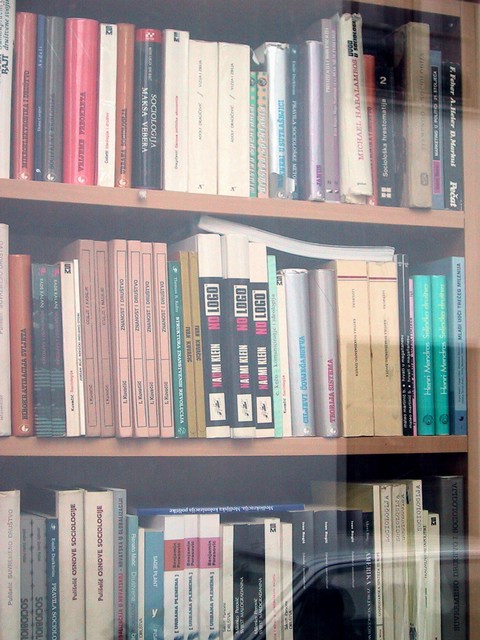
Note that there are three copies of the Naomi Klein book No Logo on the shelves.
By the way, if you missed The Take at City Cinema last week, you missed a pretty interesting movie. Directed by Avi Lewis and written by Klein, it’s a documentary about workers taking over shut factories and operating them as cooperatives, set against the background of Argentina’s tumultuous political situation.
So you want to start playing around with GIS (Geographic Information Systems) on your home PC? Here’s a simple guide on how you can start exploring maps of Prince Edward Island using only free data and free tools.
First, go and grab a copy of ArcExplorer from ESRI. This is a free basic GIS tool that will allow you to load digital map files, and do some basic queries. ArcExplorer is available for Windows, Mac, and Linux; pay attention to the “Supported Platforms” section of the download page to make sure you get the right version. Download the version you need, and follow the instructions for installing it.
Next, go to the Geobase download page for the National Road Network and download the “ESRI Shapefile” format of the file for Prince Edward Island. This is a 2MB ZIP file. Unzip the file once it has downloaded (on a Mac you can simply double-click on it; on the PC you may need a tool like WinZIP). The result will be 31 files with extensions like “shp” and “dbf.” Remember where these files ended up.
Now you’re ready to play.
Start up ArcExplorer; you’ll see a blank map screen (your ArcExplorer might not look exactly the same as below; I’m using the “Java Edition for Education” on the Mac):
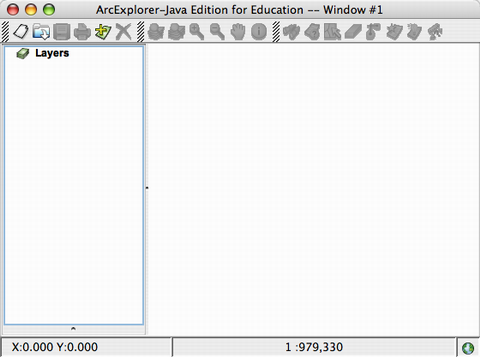
Click on the Add Data icon on the toolbar (it’s the one with the yellow “plus sign” on it):

Locate the directory where you saved your GeoBase National Road Network, highlight the file named ROADSEG.SHP, and click OK.
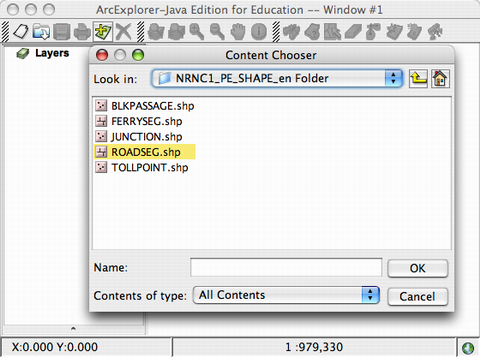
The roads of Prince Edward Island will load into the map window. Depending on the speed of your computer, and the version of ArcExplorer you’re using, this might happen instantly, or could take a minute or two. In any case, the result will look like this:

What you’re looking at are all the roads of Prince Edward Island. You’ll notice that the ArcExplorer toolbar now allows you to select a host of additional icons. For example, click the “Zoom In” icon (it’s a magnifying glass with a “plus sign” on it):

Next use your mouse to draw a box around an area of the map, the map will “zoom in” to that area. Here’s the map of Prince Edward Island’s roads “zoomed in” to Charlottetown.
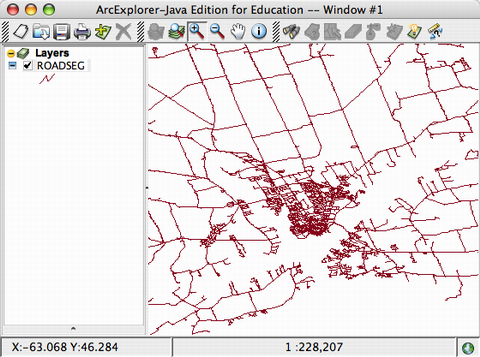
You can also “zoom out” (the magnifying glass with the “minus sign”), and pan (the hand icon; lets you drag the map to see a different area).
In the next episode, we’ll look at some of the other tools, and we’ll grab some other layers for the map.
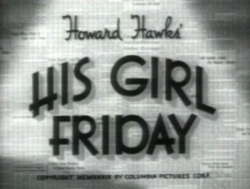 I borrowed a DVD of the 1940 Howard Hawks film His Girl Friday from the Confederation Centre Public Library earlier in the week.
I borrowed a DVD of the 1940 Howard Hawks film His Girl Friday from the Confederation Centre Public Library earlier in the week.
I was curious to find that the library’s version came from a company called “Digiview Productions,” and I was prompted to wonder where this company got the rights to the film (if indeed it did), and what the copyright status of the film is.
Looking Amazon.com reveals 12 versions of a DVD of the movie, from companies like:
- Ventura Distribution
- Marengo Films
- Good Times Home Video
- UAV Corporation
- Westlake Entertainment Group
All of these companies, from the look of their websites, appear to deal exclusively in old movies. It looks like there’s also an “official” version on DVD from Sony Pictures, the corporate ancestor of Columbia Pictures, which produced the film originally (the Sony version of the DVD has a lot of material that the Digiview version doesn’t have, including commentary, trailers, and subtitles; the Digiview version just contains the film itself and promotions for other Digiview products).
A search of the U.S. Copyright Office doesn’t show a copyright registration for the film. The Duration of Copyright page from the Copyright Office appears to say that copyright for works created before 1978 for which copyright hasn’t been renewed lasts for 28 years, which would mean that His Girl Friday had a copyright that expired in 1968.
All of which leads me to think that His Girl Friday is “in the public domain,” something that is also suggested here and here. Which, of course, prompts me to some additional questions:
- Where do the DVD distributors (like the ones above) get the print they use to make the DVD? (it says here that “virtually all DVD editions simply are sourced from previous videotapes” — is that true?)
- If this film, and apparently many others, are in the public domain, is there a public library initiative to make them available on DVD? It would seem to make sense for libraries to do this cooperatively rather than buying DVDs from companies like Digiview; with enough volume if would be both cheaper and afford the possibility of higher quality and enhanced features.
- If the film is in the public domain, can I rip it off the DVD and make it available for download on my website?
I’m also wondering about this notice at the beginning of the DVD:
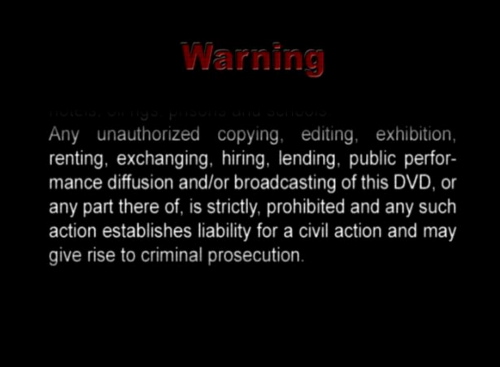
How can the distributor claim copyright on something they don’t own?
Air Canada ‘upgraded’ their aircanada.com website today, and in doing so they appear to have left Firefox (and Safari) on the Mac behind:

The “Viewing Tips” section of their site says, in part:
aircanada.com is designed to be compatible with most browsers on the Windows platform, but we recommend specific configurations. Many older versions of these browsers do not support the latest Internet technology (such as style sheets, JavaScript, SSL security or frames).
Their “Recommended Macintosh Configuration” is “Macintosh OS 9 or later / Internet Explorer 5.0 and above.”
Has anyone at Air Canada actually ever used Internet Explorer on a Mac?
I am not versed in the difference between the PAL and NTSC video standards, but I was operating under the assumption that to play on a North American television, video had to be in the NTSC format. While this might be true for other applications (videotapes?), it appears that if I have a PAL-format MPEG movie, and I use Toast to burn a VCD of it, I can still watch it on my (cheap, recently purchased, no-name) DVD player. Curious.
Our two-year-old 10GB iPod has died. After refusing to accept a charge for a week, it will now no longer start, and isn’t recognized by my iMac when I connect it by Firewire. Here’s what Apple wants to repair it, out of warranty:

A brand new 20GB iPod (they don’t make the 10GB ones any more) costs $299 $429 (I had originally looked up the U.S. price — sorry for the confusion!).
Ring ring.
“Hello, Indigo.”
“Hi there. How late are you open tonight?”
“Nine o’clock.”
“Great, thanks.”
“You gonna drop on in?”
“Sure.”
And I did.
I normally avoid Java applications, mostly because, at least in the early days of Java, such applications tended to be clunky, slow, and easily breakable. A lot has changed, and without speaking directly to the “is Java still evil?” question, I point to Azureus as a very positive example of a non-clunky, non-slow, and, at least so far, non-easily-breakable Java application.
Azureus is much more capable BitTorrent client than the ‘official’ Mac client: it gives you a lot more information about what’s flowing up and what’s flowing down, and it allows you to throttle bandwidth used in both directions.
I’ve been taking it for a ride this afternoon, and so far I’m quite impressed. Thanks to Ben Hammersley for the pointer.
By the way, in case you’re wondering, the song in opening of Closer trailer is a version of The Blower’s Daughter found on the Damien Rice album O. More details here and video of the song here.
 I am
I am